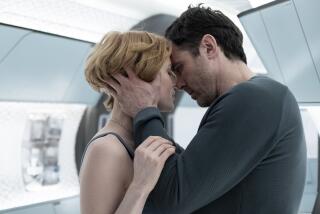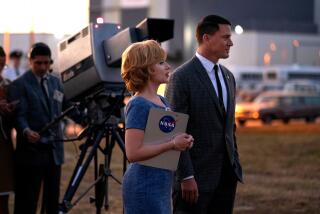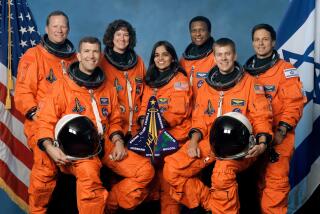ASTRONAUTS TAKE US FOR A JOY RIDE
WASHINGTON â A single spiced shrimp took flight, spinning and gently flowing upward like a lazy butterfly. Steve Hawley eyed his appetizer, took careful aim, jerked his head forward and captured it with a chomp of his jaws.
Itâs dinner time on board the space shuttle.
Zero-gravity dinner is just one of many scenes in âThe Dream Is Alive,â the first movie filmed in space, shot by 14 astronauts on three shuttle missions. The Imax film, made exclusively for screens five stories high and seven stories wide, debuted at the Smithsonianâs National Air and Space Museum here this week on what museum director Walter Boyne called âperhaps the most exciting day since we opened the museum.â
The $3.6-million film (opening Thursday at the California Museum of Science and Industry in Los Angeles) contains panoramas of Earth and the black space around it, of space walks and satellite launches and retrievals. Those whoâve been bored and confused by news reports and fuzzy pictures of the shuttle flights are in danger of falling in love with the whole venture. Even those maddening, mystifying âtilesâ that seem to keep falling off and endangering everyoneâs life are clearly shown and explained.
The 14 astronauts trained for nine months in the use of the 80-pound Imax camera, whose film frame is three times larger than 70-millimeter, producing lifelike clarity. Up in space, of course, the camera weighed nothing, but that wasnât all good news.
âThe camera had tremendous gyroscopic torque,â said one of the filmers, pilot Michael Coats. âIt was trying to go where I didnât want it to go.â
Showing reporters the inside of the camera and a film reel about a foot in diameter, Coats said: âI had nightmares about this roll of film getting loose and going all over the cabin. The spools tend to unwind.â
In one scene that moves from one level of the shuttle, down through a small hatch to another level where people are floating around every which way, Coats had to have another astronaut âhold my legs and shove me downâ the hatch headfirst while he held the camera.
The film already has been the center of considerable fanfare in Washington, where President Reagan took time out from the TWA hostage crisis to attend the premiere, along with several astronauts and prominent government officials. Astronaut Robert Crippen, who sat next to him during the movie, said the President remarked that he wouldnât have to go on the shuttle now that he had seen the movie, so thoroughly does it create the sensation of being there. And Sen. Jake Garn (R-Utah)--immortalized by cartoonist Gary Trudeau as âBarfinâ Jakeâ even before he became the first non-astronaut to ride (and not feel so well) aboard the shuttle--said the movie gave him âthe same sensationâ he had on board, although he didnât seem ill in the theater.
âWhen you add the music and Walter Cronkite (narrating),â said Coats, âitâs even better than being there.â
The movie also contains scenes of astronauts training, the control room and close-up views of takeoffs and landings.
The Lockheed Corp. funded $2.9 million of the filmâs cost, with the National Air and Space Museum adding $700,000 in a joint venture with the National Aeronautics and Space Administration. Seeking to promote the space program, NASA officials had been frustrated at astronautsâ repeated complaints that the pictures and movies they were taking aboard the shuttle flights did not adequately convey the unique vistas they were encountering.
The movie does not show any of the unpleasantness of space flight. In fact, the astronauts always appear to be having fun, and are even dressed for it, in shorts and T-shirts. âBeat Armyâ bumper stickers are slapped up here and there inside the cabin, and we see its denizens sleep, shave, brush their teeth and do everything right.
âI would expect this could have a major impact on how people perceive the space program,â said NASA Director of Public Affairs Frank S. Johnson. âIt shows that space is a place to work and live in.â
In fact, toward the end of the 38-minute film, Cronkite matter-of-factly tells viewers that âour children will live in space, and their children may be born in space.â By then, someone will have figured out how to put on the baby powder without getting it in your eyes.
More to Read
Only good movies
Get the Indie Focus newsletter, Mark Olsen's weekly guide to the world of cinema.
You may occasionally receive promotional content from the Los Angeles Times.










